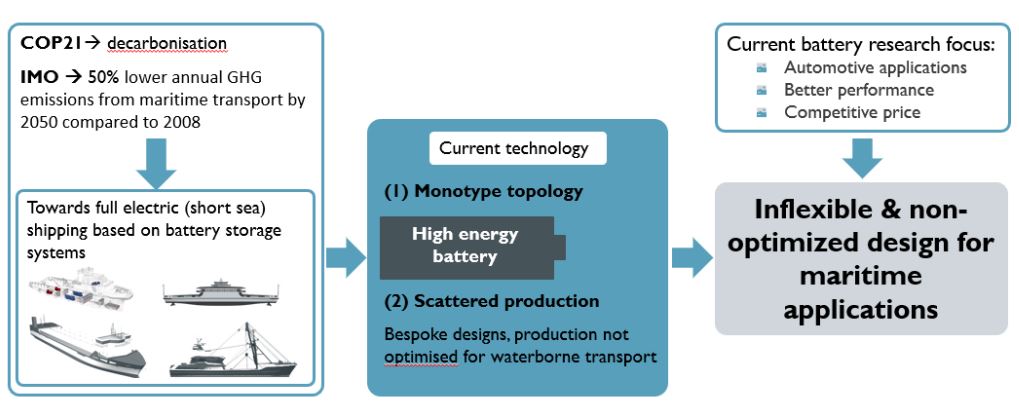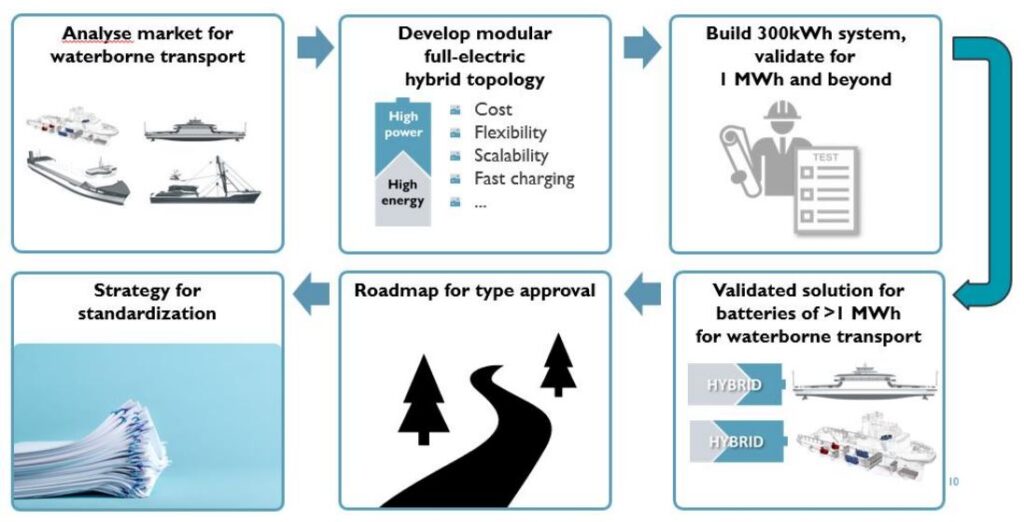Within this deliverable (D7.5) the Final business and exploitation plan is introduced for the SEABAT project. The plans are built upon the Initial business and exploitation plan (D7.3) and on the intermediate results of WP1, 2 and 3 for the project exploitation aspects, needed in the identifications of the stakeholders, market conditions and models on which the business plans are to be built. The initial chapter clarifies the overall goal and objective of the tasks in WP7 related to the exploitation of results.
Chapter 2 deals about the approach to build up the exploitation and business plans with the already delivered results from the SEABAT project. A reference in this part will be made towards WP1 results, Market needs and regulations.
1.1 Path to deliver the innovations to the market
The initially planned routes to deliver the individual innovations to the market have been mentioned in D7.3. Putting the whole path into perspective, figure 1 shows the steps to bring the SEABAT solution to the market.
Figure 1: Preliminary dissemination and exploitation timeline
The enabler of exploitation are the Stakeholders, as initially described in D7.1, SOERMAR has approached the 20 end users in its foundation and external industry partners. Further, the industrial project partners will use their existing customer base to approach potential end users.
Using the business case calculations (D3.4) these target groups will be motivated to be among the first launching customers. The next step is to demonstrate the prototypes in an operational environment (TRL 7) and qualify the systems for 1 MWh or above (TRL 8) in a pilot application.
Actions undertaken in the project to prepare the Exploitation plans:
- Organization of workshops
a. Stakeholder workshops, as presented in D7.1
b. Project workshops to identify the expected results, the R2E, the IP position and the market changes - Detailing the Business cases, based upon the performances of the SEABAT system in the different applications. These results are evaluated and discussed in D3.4.
- Identification of the market: D2.1 and D2.2
- Collection of data through: interviews, online questionnaires and dedicated one-to-one sessions with industrial partners.
- Writing exploitation & business plans, D7.5
In Chapter 3, the individual exploitation plans are explained, starting from the potential of individual
SEABAT project results, called ‘exploitation components’.
1.2 Business plans
Chapter 4 handles the related business plans, where the financial models of the exploitation of the SEABAT concept within the maritime industry are explained. Resulting in a profitability analysis that shows a yearly return of investment higher then 20%. This plan confirms the value creation potential of the modular hybrid battery solution, resulting from the SEABAT project.
The background on the business plans is presented in the results of work package 1, the Market needs and regulations, especially in deliverable D1.2– Market evolution and potential within 5, 10, 15 years for different marine applications. The basis for the business plans is based on the overall roadmap of the SEABAT project, support the decarbonization of the maritime applications (COP21), and 50% lower annual GHG emissions from maritime transport by 2050 compared to 2008 (IMO).
Figure 2: SEABAT background
The business plans, do not cover only the company specific and individual business cases, since the
sector is depending on various aspects influencing the business cases. These are, among others,
piloting & validation of prototype systems, type approval and standardization of components, (sub-)
systems & infrastructure. These aspects will are taken care of in the SEABAT project in WP5, 6 and 7
respectively.
1.3 Structure of the Business Plan
The business plan that is being built up here, follows the approach of a business model canvas and it’s different aspects. All of them will be discussed in the following sections, which are:
• Executive summary: overview, highlights of what business plan covers, and it’s conclusions.
• Business Description: description of the business scope that is considered in the overall business plan and its goals, products, services & target customer base.
• Product or services breakdown: describe products/services & what distinguishes the company from its competitors for each product or service.
• Key value propositions & SWOT Analysis: identify detailed list of strengths, weaknesses, opportunities & threats in relation to the value propositions towards the market.
• Market Analysis & Strategy: search & identify company’s primary target audience and where to find the customer segments. Including a marketing an communication strategy.
• Management & partnership description: explained what the key partnerships are, with their (legal) dependencies and interactions.
• Key resources and operational Plan: an overview on how to organise the key activities, with a consideration of locations, IPR and HR requirements.
• Financial Plan and costing structure: insight into the costs and revenues within this business plan, with an analysis towards profitability and Return On Investment (ROI).
The outcomes of the business plans are presented in the confidential document and will be summarised at the final event to the Stakeholders and other interested audience.
Click here for more information.


